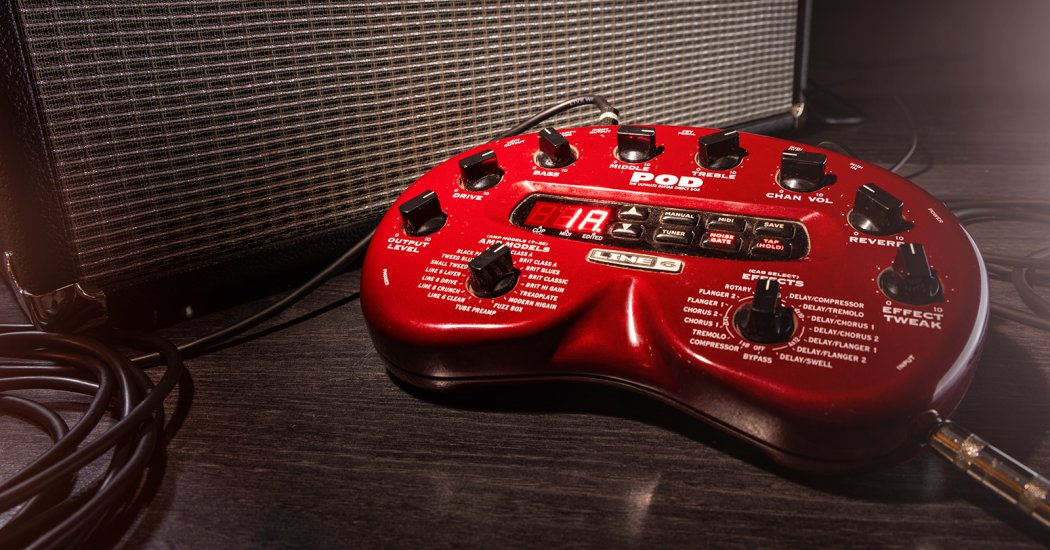
In today’s cutting-edge world of Quad Cortexes, Axe-Fxes, TONEXes, Headrushes, Kempers, and Helixes, it’s easy to forget that, just a couple of decades ago, it was nearly impossible to get an authentic-sounding miked-cab tone without an amplifier, cabinet, and microphone. While there were several near misses in the years leading up to its release in 1998, it was Line 6’s POD that finally cooked up a dish with the right combination of ingredients to make realistic amp modeling and amp-free recording a practical reality. Indeed, without Line 6’s game-changing invention, the state-of-the-art products we take for granted in modern times, such as the Strymon Iridium, might not even exist. And Line 6 is still at it today. So, to celebrate the release of Line 6’s newest POD Express units, we wanted to revisit the history of the device that kick-started the ampless revolution.
DI-ing Guitar: The Early Years
In the pre-digital era, getting a traditional electric guitar sound entailed putting a microphone in front of a speaker cabinet. Engineers did DI guitars, of course, but they did it to get a specific sound with no expectation that the recording would sound anything at all like a miked-up amp. Prime examples of these oddball (but eminently cool) tones are Jimmy Page’s muscular riffage on Led Zeppelin’s “Black Dog” and Thomas McClary’s greasy solo on the Commodores’ “Easy.”
In fact, clean guitar tones, especially during the late 1970s and throughout the 1980s, were DI-ed specifically because they didn’t sound like an amplifier; a guitar plugged straight into a console retains its full harmonic content since you’re not filtering it through the confined frequency response of a guitar speaker. Check out Chic’s “Le Freak” for a stellar example of an in-your-face DI-ed clean tone.
High-gain guitar tones, on the other hand, were rarely DI-ed since, without an amp and speaker to smooth out the upper frequencies, a distorted tone sounds buzzy and fizzy — like the proverbial bees in a jar. To experience this for yourself, plug your axe into a Pro Co RAT or a BOSS DS-1 then plug the pedal straight into your audio interface (you’ll probably want to cover your ears though).
Fake It ’til You Make It
Despite its massively inferior sound, it’s hard to deny the convenience of DI-ing an electric guitar. This is especially true for home recordists, who are often required to keep their noise levels below a certain threshold. Thus, when the home recording revolution gained steam in the 1980s and 1990s, guitarists began clamoring for a way to achieve miked-amp guitar tones without the cranked-up amplifier.
One of the earliest products to achieve the sound of a miked-up amplifier without an amplifier was the Scholz Rockman, which was released in 1982. While it was designed as a headphone practice amp, the Rockman also gained notoriety as a DI box. Unfortunately, the Rockman didn’t offer a wide variety of tones. Since it was designed by Tom Scholz (of Boston fame), the Rockman sounded like Boston. If you wanted to record a cover of “More Than a Feeling,” then the Rockman delivered the goods; if you wanted to sound like anything other than Boston, however, you were out of luck.
Another standalone DI solution was the Hughes & Kettner Cream Machine, which was unveiled in 1987. This tube-loaded contraption was essentially a low-wattage, British-style guitar amp head combined with a crude analog cabinet emulator that employed a fixed EQ curve to filter out any excessive top-end fizziness. The Cream Machine was revolutionary for its time, and it sounded much better than plugging a distortion pedal straight into a recording device, but even back then, few musicians really believed that it sounded exactly like a miked guitar cabinet. Good as it was, it was merely a compromise.
The most effective pre-digital amplifier emulator was arguably the Tech 21 SansAmp, which launched in 1989. The SansAmp was a stompbox-style device that achieved amp-like overdrive using solid-state electronics. A series of switches enabled you to select among the various tonal characteristics inherent in many popular types of guitar amplifiers and cabinets. While the SansAmp was, at its most basic, a glorified distortion pedal, it did provide musicians with a useful array of record-ready guitar tones.
Enter the POD
By the late 1990s, it appeared that the industry had moved past the whole guitar DI thing. Tom Scholz’s company had been sold off; Hughes & Kettner gave up on the Cream Machine; and SansAmps were finding themselves relegated to basic stompbox duties about as often as to studio recording. But, in 1998, a scrappy upstart called Line 6 unveiled the first bona-fide game changer in the realm of DI-ed guitar: the POD.
Initially, the POD was a bit of an enigma. It was an odd-looking, kidney-bean-shaped desktop unit with a series of amplifier-esque knobs, a couple of rows of buttons, and an alphanumeric LED screen. But lurking among its mysterious innards was a candy shop of ear-grabbing digital models of guitar amplifiers, a virtual stockpile of speaker-cabinet emulations, and a sizable cache of stompbox-style effects. The amp models sounded surprisingly authentic — given the technological confines of the late ’90s — and, best of all, guitarists could access all this cool stuff using a single portable unit that was far cheaper than purchasing a room full of amplifiers, speaker cabs, and pedals.
The POD brandished a slew of pro-level features, including recallable patches, MIDI connectivity, and deep editing via your Mac or PC. You could connect the POD straight to your recording setup; plus, there was a dedicated setting for running the unit in live applications. You could expand the POD with a foot controller for hands-free patch selection, individual effect activation, and real-time parameter control over its wah-wah and volume-pedal emulations. The POD even included a built-in tuner!
The industry reaction to the POD was overwhelmingly enthusiastic. And the praise wasn’t limited to home recordists. The POD found favor with engineers, producers, and guitarists of all stripes all over the world. Indeed, in the late ’90s and early aughts, almost every recording studio, from the hole-in-the-wall cesspits to the expensive professional rooms downtown, had a POD in their arsenal. As such, it’s a sure bet that a massive number of that era’s hit albums were produced using a POD on at least some of their guitar tracks.
The Evolution of the POD
The POD has gone through several revisions during its quarter-century run. Thanks to constantly improving memory capacity, processing power, and other technological advances, each generation of the POD has sounded better than the last and has featured more models onboard and expanded capabilities.
The original POD boasted 16 guitar-amp models along with cabs and effects. The POD 2.0, which appeared in 2000, expanded its arsenal to 32 amp models. 2002’s POD XT included 42 models and 60 effects, and it was possible to upgrade it further with model packs. A year later, Line 6 released the first version of the POD designed specifically for bassists. In 2007, the POD X3 featured a whopping 78 models, allowed for playing through two signal chains simultaneously, and brandished a built-in preamp for vocals.
The POD has seen numerous form factors throughout its lineage, as well, including the original kidney-bean-shaped desktop model and its descendants, professional rackmount offerings, portable pocket-sized units, and floorboard-style units tailor-made for live performance.
The POD Today
As of 2024, Line 6 is still innovating; the POD Express Guitar and POD Express Bass models represent their most recent offerings. These ultra-portable processors put a surprisingly robust number of amps and effects at your feet, and since they can run on either batteries or a traditional 9-volt power supply, you can take them with you anywhere. Both units give you seven amp and cab simulations as well as 17 effects, including a looper. They include stereo outputs and a stereo headphone output with modeling derived from Line 6’s high-end HX processors, ensuring a superior sound and feel. You also get a convenient USB-C connection for plug-and-play recording, monitoring, and re-amping along with a tuner and a noise gate. Both the POD Express Guitar and the POD Express Bass will accommodate an optional expression pedal for volume control or up to two external footswitches for selecting presets or turning effects on and off.
Feeling Left Out?
Do you feel like the only kid on the block without a POD? Never fear, our friendly Sweetwater Sales Engineers will be happy to hook you up. Give us a call at (800) 222-4700, and we’ll get you a brand-spanking-new Line 6 POD for your studio or stage rig. Got something more retro in mind? Then check out the Sweetwater Gear Exchange and get your hands on an authentic piece of POD history.





